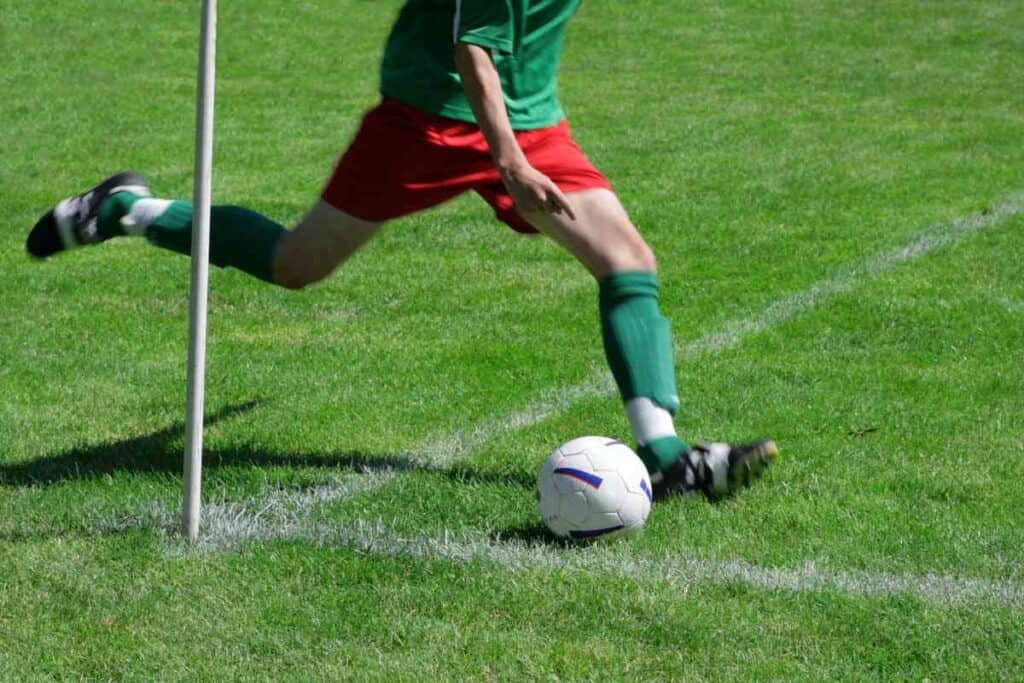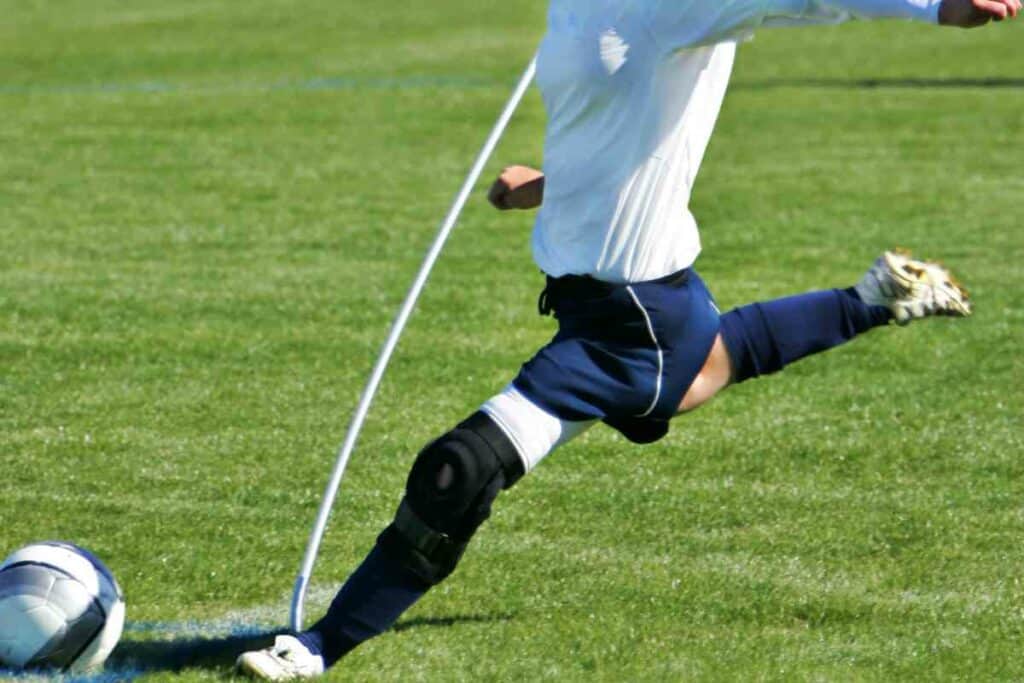Corner Kick in Soccer: Everything You Need to Know

A corner kick provides an excellent opportunity for the attacking team to score a goal. The attacking team can use various tactics to take advantage of the situation and score a goal. The defending team can also use their tactics to prevent the attacking team from scoring a goal. Therefore, a corner kick can be a game-changer in a soccer match.
Check out my guide to the most common soccer terms to make sure you’re boned up!
What’s a corner Kick In Soccer?
Corner kicks are an essential part of soccer. When the ball goes out of play over the goal line, without a goal being scored and having last been touched by a member of the defending team, a corner kick is awarded to the attacking team. The kick is taken from the corner of the field of play nearest to the place where the ball crossed the goal line.
In this article, we will explore everything you need to know about corner kicks in soccer. We will cover the rules of taking a corner kick, the different types of corner kicks, and the tactics used by both the attacking and defending teams during a corner kick. Whether you are a soccer enthusiast or a player looking to improve your skills, this article will provide you with a comprehensive understanding of corner kicks in soccer.
Understanding Corner Kick
Definition
A corner kick is a set-piece in soccer that is awarded to the attacking team when the ball goes out of play over the goal line, having been last touched by a defending player. The kick is taken from the corner arc closest to where the ball went out of play. It is an opportunity for the attacking team to create a scoring chance, while the defending team tries to clear the ball from danger.
Procedure
When the referee signals for a corner kick, the attacking team positions its players in and around the penalty area, while the defending team sets up to try and prevent a goal. The ball must be stationary when the kick is taken, and the kicker cannot touch the ball again until it has been touched by another player. The defending team must stay at least 10 yards away from the ball until it is in play.
The corner kick can be taken in different ways, depending on the situation and the team’s strategy. Some common techniques include the inswinger, where the ball curves towards the goal, and the outswinger, where the ball curves away from the goal. The kick can also be taken short, with a player passing the ball to a teammate instead of crossing it into the box.
Corner kicks are an important part of the game, but they do not always result in goals. According to statistics, only about 3-4% of corner kicks end up in the back of the net. However, they can still be a valuable tool for a team to create scoring opportunities and put pressure on the opposition.
In conclusion, understanding the rules and procedures of corner kicks is essential for any soccer player or fan. The kick provides an opportunity for the attacking team to create a goal-scoring chance, while the defending team tries to prevent it. By knowing how to take and defend against corner kicks, teams can improve their chances of success on the field.
Corner Kick Rules

A corner kick is a set-piece in soccer that is awarded to the attacking team when the ball goes out of play at either end of the field after being last touched by a defending player. In this section, we will discuss the rules that govern corner kicks.
In Play
Once the referee has awarded a corner kick, the ball is in play when it is kicked and clearly moves. The attacking team can score a goal directly from a corner kick, but only against the opposing team. If the ball directly enters the kicker’s goal, a corner kick is awarded to the opposing team. The attacking team must kick the ball back into play, and all players must be outside the penalty area until the ball is in play.
Out of Play
A corner kick is awarded when the whole of the ball passes over the goal line, on the ground or in the air, having last touched a player of the defending team, and a goal is not scored. The ball is considered out of play until it is kicked and clearly moves.
Offside Rule
The offside rule does not apply during a corner kick. The attacking team can have players in an offside position when the corner kick is taken, as long as they are not interfering with play. If a player in an offside position touches the ball before it is touched by another player, the referee will award a free kick to the defending team.
In summary, the rules for a corner kick in soccer are straightforward. The ball is in play when it is kicked and clearly moves, and the attacking team can score directly from a corner kick. The offside rule does not apply during a corner kick, but players in an offside position must not interfere with play.
Roles and Responsibilities
Attacking Team
During a corner kick, the attacking team’s primary objective is to score a goal. Here are some of the roles and responsibilities of the attacking team during a corner kick:
- Players should position themselves strategically in the penalty box to maximize their chances of scoring.
- The player taking the corner kick should aim the ball towards the designated areas where their teammates are positioned.
- Other players should create space and make runs to confuse the defenders and create opportunities for themselves or their teammates.
- Players should be prepared to react quickly to any deflections or rebounds off the defenders or the goalkeeper.
Defending Team
The defending team’s main goal during a corner kick is to prevent the attacking team from scoring. Here are some of the roles and responsibilities of the defending team during a corner kick:
- Players should mark their opponents to prevent them from getting free headers or shots on goal.
- The goalkeeper should position themselves correctly and be ready to save any shots that come their way.
- Defenders should clear the ball out of the penalty box as quickly as possible to avoid any further danger.
- Players should communicate effectively with each other to ensure that everyone is aware of their responsibilities and any potential threats.
Goalkeeper
The goalkeeper plays a crucial role during a corner kick, as they are the last line of defense for the defending team. Here are some of the roles and responsibilities of the goalkeeper during a corner kick:
- The goalkeeper should position themselves correctly according to the attacking team’s setup and the position of the ball.
- They should be prepared to make saves on any shots or headers that come their way.
- The goalkeeper should communicate effectively with their defenders to ensure that everyone is aware of their responsibilities.
- If the goalkeeper catches the ball, they should look to distribute it quickly to start a counter-attack.
Overall, a successful corner kick requires coordination, communication, and execution from both the attacking and defending teams.
Types of Corner Kicks
Corner kicks are a great opportunity for teams to score goals. However, there are different types of corner kicks that can be used to create different scoring opportunities. In this section, we will discuss three types of corner kicks: Short Corner, In-Swinging Corner, and Out-Swinging Corner.
Short Corner
A short corner is when the ball is played to a teammate who is closer to the corner flag than the penalty box. This type of corner kick is often used when the attacking team wants to maintain possession of the ball and create a better angle for a cross or shot. A short corner can also be used to catch the defending team off guard and create a scoring opportunity.
In-Swinging Corner
An in-swinging corner is when the ball is kicked towards the goal, curving inward towards the goalkeeper. This type of corner kick is effective when the attacking team has players who are good in the air and can get on the end of the cross. It is also effective when the goalkeeper is not confident in dealing with crosses and can be caught off guard.
Out-Swinging Corner
An out-swinging corner is when the ball is kicked away from the goal, curving outward towards the edge of the penalty box. This type of corner kick is effective when the attacking team has players who are good at shooting from distance or when the defending team has tall players who can clear the ball from the box.
Overall, the type of corner kick used will depend on the situation and the strengths of the attacking team. It is important to practice different types of corner kicks in order to be able to use them effectively during a game.
Corner Kick Tactics

Corner kicks are a great opportunity for a team to score a goal. With the right tactics, positioning, and set plays, a team can increase their chances of scoring from a corner kick. In this section, we will discuss the different tactics that can be used to make the most of a corner kick.
Positioning
Positioning is crucial when it comes to corner kicks. The attacking side needs to position their players strategically to create scoring opportunities. The following are some key points to keep in mind when positioning players during a corner kick:
- Have at least one player near the goalkeeper to block their view and prevent them from coming out to catch the ball.
- Place a player at the near post to flick the ball on towards the goal.
- Have a player at the far post to head the ball in if it goes over the goalkeeper.
- Place a player on the edge of the box to strike the ball if it is cleared by the defense.
Set Plays
Set plays are pre-planned moves that can be used during a corner kick. They can be effective in confusing the defense and creating scoring opportunities. The following are some set plays that can be used during a corner kick:
- Short corner: Instead of crossing the ball into the box, pass it to a nearby player who can then cross it into the box or take a shot on goal.
- Far post: Aim the ball towards the far post where a player can head it in.
- Near post: Aim the ball towards the near post where a player can flick it on towards the goal.
- Dummy: Have a player near the ball pretend to take the kick but instead let it roll to another player who can then take the kick.
It is important to practice set plays during training sessions to ensure that they are executed correctly during a game.
In conclusion, positioning and set plays are important tactics that can be used during a corner kick. With the right tactics and execution, a team can increase their chances of scoring from a corner kick.
Corner Kick in Different Scenarios
Corner kicks are an important part of soccer and can occur in several situations. In this section, we will discuss corner kicks in different scenarios.
Goal Kick
A goal kick is awarded to the defending team when the ball goes out of bounds over the goal line, and the attacking team was the last to touch it. In this scenario, the defending team takes the goal kick, and the ball is placed anywhere within the six-yard box. Once the ball is in play, any player can touch it, including the player who took the goal kick.
Throw-In
A throw-in is awarded to the team that did not touch the ball last before it went out of bounds on the sidelines. The player taking the throw-in must have both feet on the ground and use both hands to throw the ball back into play. The ball can be thrown in any direction, and the player taking the throw-in cannot touch the ball again until another player has touched it.
Free Kick
A free kick is awarded to a team when a foul is committed by the opposing team. The ball is placed at the spot where the foul occurred, and the free kick can be taken by any player on the team that was fouled. The opposing team must be at least 10 yards away from the ball when the free kick is taken.
Penalty Kick
to the attacking team when a foul is committed by the defending team inside their own penalty box. The ball is placed on the penalty spot, and the penalty kick is taken by a player from the attacking team. The goalkeeper is the only player from the defending team allowed to defend the penalty kick.
In conclusion, corner kicks are just one of the many set pieces in soccer. Each set piece has its own rules and procedures, and it is important for players to understand them in order to play the game effectively.
Throw-In
A throw-in is awarded to the opposing team when the ball goes out of bounds over the touchline. In this scenario, a corner kick is not awarded.
Free-Kick
A free-kick is awarded to a team when a foul occurs outside the penalty area. In this scenario, a corner kick is not awarded. However, if the ball goes out of bounds over the goal line, and the defending team was the last to touch it, a corner kick is awarded to the attacking team.
Indirect Free-Kick
An indirect free-kick is awarded to a team when a non-penal foul occurs outside the penalty area. In this scenario, a corner kick is not awarded. However, if the ball goes out of bounds over the goal line, and the defending team was the last to touch it, a corner kick is awarded to the attacking team.
In conclusion, corner kicks can occur in different scenarios in soccer, and it’s essential to understand the rules and regulations that govern each situation. By doing so, players can take advantage of these opportunities and increase their chances of scoring a goal.
Famous Corner Kick Plays

Corner kicks are a crucial part of soccer, and many teams have developed unique and successful plays to take advantage of them. In this section, we’ll take a look at some of the most famous corner kick plays used by top teams and national squads.
Manchester United
Manchester United is one of the most successful soccer clubs in history, and their corner kick plays have played a significant role in their success. One of their most famous corner kick plays is the “Fergie Flick,” named after their former manager Sir Alex Ferguson. This play involves a short corner kick to a player who flicks the ball with their heel to a teammate who is running towards the goal. This play has resulted in several goals for Manchester United over the years.
England
England’s national soccer team has a long history of success, and their corner kick plays have played a significant role in their victories. One of their most famous corner kick plays is the “Geoff Hurst,” named after the player who scored a hat-trick in the 1966 World Cup final. This play involves a cross to the far post, where a player jumps and heads the ball back across the goal for a teammate to score.
World Cup
The World Cup is the most prestigious soccer tournament in the world, and teams from all over the globe compete for the coveted trophy. Over the years, several teams have developed famous corner kick plays that have helped them win the tournament. One of the most famous is Brazil’s “Jairzinho,” named after the player who scored in every game of the 1970 World Cup. This play involves a short corner kick to a player who dribbles towards the goal and takes a shot on goal or crosses the ball to a teammate.
Other famous corner kick plays used in the World Cup include Germany’s “Helmut Rahn,” named after the player who scored the winning goal in the 1954 final, and Argentina’s “Maradona,” named after the legendary player who led his team to victory in the 1986 tournament.
In conclusion, corner kick plays are an essential part of soccer, and teams and national squads have developed unique and successful plays over the years. Manchester United’s “Fergie Flick,” England’s “Geoff Hurst,” and Brazil’s “Jairzinho” are just a few examples of the famous corner kick plays used in soccer.
Common Confusions and Clarifications

Difference Between Corner Kick and Other Kicks
One common confusion with corner kicks is the difference between them and other types of kicks. A corner kick is awarded to the attacking team when the ball goes out of play over the goal line, while a goal kick is awarded to the defending team when the ball goes out of play over the goal line but was last touched by an attacking player.
Another type of kick that is often confused with corner kicks is a free kick. Free kicks can be awarded for various fouls and are taken from the spot where the foul occurred. Unlike corner kicks, free kicks can be taken from anywhere on the field, and the opposing team must be at least 10 yards away from the ball.
Offside Rule in Corner Kick
Another area of confusion with corner kicks is how the offside rule applies. If a player is in an offside position when the corner kick is taken and then becomes involved in play, the goal will be disallowed. However, if the player is not involved in play, the goal will stand.
It’s important to note that the offside rule only applies if the ball is touched by another player before it goes into the goal. If the ball goes directly into the goal from the corner kick, there is no offside.
Own Goal Scenario
A common confusion with corner kicks is whether or not an own goal can be scored directly from a corner kick. The answer is yes, an own goal can be scored directly from a corner kick. If a defending player touches the ball and it goes into their own goal, it will count as an own goal.
It’s also important to note that if a player takes a corner kick and the ball goes directly into their own goal without being touched by another player, it will count as a goal for the opposing team.
Overall, understanding the differences and rules surrounding corner kicks can help players and fans better appreciate the strategy and excitement of this important aspect of soccer.
Frequently Asked Questions
What is a corner kick in soccer?
A corner kick is a type of free-kick awarded to the attacking team when the ball goes out of play across the defending team’s goal line. The kick is taken from the quarter circle in the corner of the field nearest to where the ball went out of bounds.
When is a corner kick awarded in soccer?
A corner kick is awarded when the ball goes out of play over the defending team’s goal line, either on the ground or in the air, and the defending team was the last to touch the ball.
What is the purpose of a corner kick?
The purpose of a corner kick is to give the attacking team an opportunity to score a goal. The attacking team will try to kick the ball towards the goal area, where their teammates can attempt to head or kick the ball into the net.
Can you kick a corner kick directly into the goal?
Yes, it is possible to score a goal directly from a corner kick. However, it is difficult to do so because the goal is heavily defended by the opposing team.
What is the difference between a goal kick and a corner kick?
A goal kick is awarded to the defending team when the ball goes out of play over the attacking team’s goal line, and the attacking team was the last to touch the ball. The goal kick is taken from the six-yard box. In contrast, a corner kick is awarded to the attacking team when the ball goes out of play over the defending team’s goal line, and the defending team was the last to touch the ball. The corner kick is taken from the corner arc.
What is the strategy for taking a corner kick in soccer?
The strategy for taking a corner kick depends on the team’s tactics and the situation of the game. Some common strategies include playing the ball short to a teammate, crossing the ball into the goal area, or taking a shot on goal. The attacking team may also use various formations and movements to confuse the defending team and create scoring opportunities.
